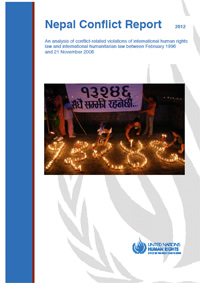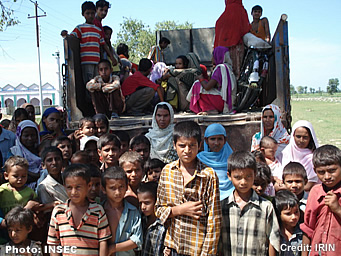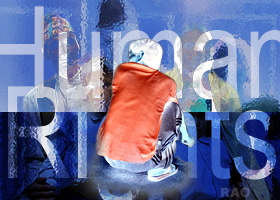|
Nepal
1996- 2006: Human Rights
|
|
| Human
Rights & Social Justice |
|
|
|
Nepal Conflict Report 1996-2006
|
 |
GENEVA (8 October 2012)
UN releases report charting ten years of violations during Nepal conflict
 |
|
The UN High Commissioner for Human Rights released a landmark report Publicationing and analysing serious violations of international law that occurred during the ten-year (1996-2006) conflict in Nepal, along with a database of around 30,000 Publications, designed to provide a tool for Nepalese institutions and civil society to kick-start the process of seeking truth, justice, and reconciliation for the crimes committed at that time.
In her introduction to the 233-page Nepal Conflict Report, UN human rights chief Navi Pillay said the report and the huge accompanying database, known as the Transitional Justice Reference Archive, are "intended to be a helpful contribution to the pressing task of ensuring justice for serious violations committed during the conflict.
|
|
Pillay noted that in 2006, when the Government of Nepal and the Communist Party of Nepal (Maoist) signed the Comprehensive Peace Agreement, they committed to "establishing the truth about the conduct of the conflict and ensuring that the victims… receive both justice and reparations."
"Six years later," she added, "the transitional justice mechanisms promised in the peace accords have still not been established, and successive governments have withdrawn cases that were before the courts. Perpetrators of serious violations on both sides have not been held accountable, in some cases have been promoted, and may now even be offered an amnesty."
According to the report, which contains data illustrating the temporal and geographical spread of the violations committed by both sides during the increasingly brutal ten-year conflict, at least 13,000 people were killed, with a further 1,300 still missing. The report notes that the final death toll is likely to have been higher, with Government figures now citing 17,000 killed.
The report focuses on five particular categories of violations – unlawful killings, disappearances, torture, arbitrary arrests and sexual violence – and gives details of 41 specific emblematic cases drawn from the database. It suggests that several such cases might amount to war crimes.
 |
|
"Unlawful killings occurred throughout the conflict in multiple contexts: for example, during Maoist attacks on Security Force posts and bases, Government buildings, national banks and public service installations; in chance encounters and during ambushes, such as in the Madi bus bombing. Other examples were recorded during search operations by the Security Forces made in response to earlier Maoist attacks and in the way that the local People's Liberation Army [military wing of the Maoists] and political cadres abducted, abused, tortured and killed suspected spies and informants."
|
|
"Unlawful killings were also perpetrated against enemy combatants and civilians who were in detention or otherwise under the control of the adversary, for example, in execution-style killings," the report says, adding that one of the most compelling cases occurred at Doramba in central Nepal, where 17 Maoists and two civilians were allegedly taken by the Royal Nepal Army (RNA), marched to a hillside, lined up and summarily executed. "The Maoists also killed captives," the report continues, "for example, three teachers, Muktinath Adhikari, Kedar Ghimire and Arjun Ghimire, were each allegedly executed after abduction in separate incidents in Lamjung District in 2002."
The archive records "up to 9,000 serious violations of international human rights law or international humanitarian law may have been committed during the decade-long conflict.... However, at the time of writing, no one in Nepal has been prosecuted in a civilian court for a serious conflict-related crime."
"Accountability therefore remains a matter of fundamental importance to Nepal as it deals with its legacy of conflict."
The report expresses concern at moves by successive governments to withdraw cases of "a political nature" and at recent Government proposals that the planned future Truth and Reconciliation Commission [TRC] be given broad amnesty powers.
"The Government has moved to empower the TRC to grant amnesties for international crimes and gross violations of international law committed during the conflict," the report says. "The granting of amnesties for certain crimes, particularly genocide, crimes against humanity and war crimes, contravene principles under international law. … Not only do amnesties contravene international human rights law by upholding impunity, they also weaken the foundation for a genuine and lasting peace."
The issues of accountability and impunity came into sharp focus last week, when it was revealed that the Government of Nepal had decided to promote Colonel Raju Basnet to the rank of Brigadier General, despite repeated reminders from the UN Human Rights office, the National Human Rights Commission of Nepal and others that a battalion under the command of Basnet was heavily implicated in the alleged arbitrary detention, torture and disappearance of individuals alleged at the Maharajgunj Barracks in 2003-04. Similar concerns have been expressed about the recent appointment as Inspector General of the Nepal Police of Mr. Kuber Singh Rana, who has also been accused of serious human rights violations during the conflict.
In her foreword, Pillay said the report and the archive provide "a research base on which the transitional justice commissions and courts will be able to build. The Report is intended to act as an initial compilation of credible allegations of serious violations of international law. These allegations are presented in the context of relevant laws and evidence, to provide the basis for further investigation and prosecution by a Nepali judicial process."
Pillay said she was offering the report and archive "to the Government and people of Nepal, to assist them in their essential task of building a sustainable foundation for peace."
The Office of the UN High Commissioner for Human Rights (OHCHR) maintained a substantial field office in Nepal from 2005 to 2012, which was mandated to observe human rights under the Comprehensive Peace Agreement. The Government of Nepal did not renew OHCHR's mandate in Nepal in December 2011 and asked the office to wrap up its operations in the country. Much of the Publicationation in the archive was collected in the course of OHCHR's work in Nepal.
| Source: UN Office of the High Commissioner for Human Rights OHCHR, October 2012 |
 |
top
|
WHAT IS THE NEPAL CONFLICT REPORT?
|
 |
OHCHR's Nepal Conflict Report Publications and analyses the major categories of conflict-related violations of international human rights law and international humanitarian law that took place in Nepal from February 1996 to 21 November 2006. The 233 page Report was compiled by the United Nations Office of the High Commissioner for Human Rights (OHCHR) as a contribution to the transitional justice process in Nepal.
WHAT IS THE TRANSITIONAL JUSTICE REFERNCE ARCHIVE?
The cases and data in the Nepal Conflict Report are derived from the Transitional Justice Reference Archive (TJRA), a database of approximately 30,000 Publications and cases. The Publications contained in this database, in both English and Nepali language, were compiled from a wide range of credible sources including national and international NGOs as well as OHCHR-Nepal's own reporting over the last six years. Most of the Publications are reports and other materials already available in the public domain. This database was developed as an information management tool that allows for elaborated research into the incidents that have been included. The TJRA is an indispensible partner to the Report and is freely available on the OHCHR website.
WHAT IS THE PURPOSE OF THE REPORT?
By contributing to the Publicationation and compilation of serious violations of human rights and international humanitarian law committed in Nepal during the conflict, the Report aims to assist the Government of Nepal, the future transitional justice commissions, the National Human Rights Commission and civil society to advance transitional justice, combat impunity and enable the conflict's many victims to obtain justice. OHCHR offers this Report and the TJRA as a contribution to the important task of preserving information and establishing the truth about serious violations committed during the conflict.
WHAT ARE THE CORE MESSAGES OF THE REPORT?
1. Under international law, the Government of Nepal has a fundamental obligation to investigate and prosecute serious violations of international human rights law and international humanitarian law that were committed during the conflict.
2. Where there is a reasonable basis for suspicion that a serious violation of international law occurred, these cases merit prompt and independent investigation by a full judicial process
3. The transitional justice mechanisms are an important part of this process but should complement criminal justice processes and not be an alternative to them
WHICH CRIMES ARE EXAMINED IN THE REPORT?
The Report focuses on the most serious categories of violations observed during the conflict: unlawful killings, disappearances, arbitrary arrest, torture and sexual violence. It also examines obstacles to victims obtaining an effective remedy.
ARE PERPETRATORS AND VICTIMS NAMED IN THE REPORT?
Cases of alleged violations are discussed in the Report to illustrate the application of international law. The names of perpetrators and victims are not stated in the Report or the TJRA unless this information has already been disclosed in publicly available Publications. The Report is not intended to make judgements about individual cases or to declare individuals guilty. The Report is intended to show that were there is a credible allegation that amounts to a reasonable basis for suspicion that a serious violation of international law has occurred, it merits prompt, impartial, independent and effective investigation by a full judicial process.
WHICH PARTY TO THE CONFLICT COMMITTED THE MOST VIOLATIONS?
The Report does not make a "scorecard" of how many violations were committed by each party to the conflict. This is not the purpose of this Report. Instead, within the framework of international law, the Report analyses alleged violations that occurred on both sides of the conflict to determine if there is sufficient basis to believe that serious violations of international law occurred. Emblematic cases involving personnel from all sides of the conflict are used to illustrate the application of international law relating to unlawful killings, enforced disappearance, torture, arbitrary arrest and sexual violence.
HOW CAN OHCHR MAKE THESE ALLEGATIONS WITHOUT A JUDICIAL PROCESS?
OHCHR emphasizes that it is has not undertaken this project as a court of law.OHCHR is not itself alleging the commission of a crime or violation in respect of each incident in the TJRA or in the cases cited in the Report. OHCHR is stating, however, that a credible allegation - amounting to a reasonable basis for suspicion – exists in respect of each incident, and merits prompt, impartial, independent and effective investigation by a full judicial process.
WHO'S REPORT IS THIS? ARE THESE REVELATIONS NOT ALREADY PUBLICALLY AVAILABLE?
The Nepal Conflict Report, and the compilation of Publications and cases into the TJRA, was a project authorised by the High Commissioner for Human Rights and undertaken by her Office, OHCHR. The High Commissioner for Human Rights has an independent global mandate given by the United Nations General Assembly to promote and protect the effective enjoyment of human rights by all, and to prevent the continuation of human rights violations throughout the world. It is true that the Publicationation and cases on which the analysis in the Report is based are already publically available in Nepal. They were obtained from various sources including the Government, the National Human Rights Commission, civil society organisations and official publications of the parties to the conflict. However, the framework of applicable international law presented in the Report, and the analysis of the cases, national laws and national processes within this international framework, is entirely the work of OHCHR. OHCHR has done similar reports in other countries recovering from conflict.
THIS REPORT ANALYSES THE NEPAL CONFLICT WITHIN THE FRAMEWORK OF INTERNATIONAL LAW. DOES THIS MEAN THAT NEPALI DOMESTIC COURTS HAVE NO JURISDITION OVER CONLFICT RELATED CASES?
No, Nepali domestic courts are the right place for conflict related cases to be tried. International law obligates the Government of Nepal to undertake investigations of serious human rights violations committed during the conflict, and to prosecute them in a fully competent court of law. In addition, article 8 of the Universal Declaration of Human Rights enshrines the right to a remedy: "Everyone has the right to an effective remedy by the competent national tribunals for acts violating the fundamental rights granted him by the constitution or by law."
According to the Publications examined in the course of compiling this Report, it is reasonable to suspect that up to 9,000 serious human rights or international humanitarian law violations may have been committed during the decade-long conflict. However, at the time of writing this report, no-one in Nepal has been prosecuted in a civilian court for a serious conflict-related crime.
WILL THIS REPORT BE CONSIDERED BY THE INTERNATIONAL CRIMINAL COURT?
Nepal has not yet become a party to the Rome Statute of the International Criminal Court (ICC), nor has Nepal been referred to the ICC by the Security Council. Therefore the ICC does not have jurisdiction over the crimes committed during the conflict in Nepal.
DOES OHCHR BACK THE FACTS IN THE REPORT?
Using its expertise as the United Nations agency responsible for human rights, OHCHR presents a comprehensive and authoritative framework of international law relevant to the crimes committed during the conflict. However, the facts contained in the cases themselves are mostly allegations. They need to be subject to prompt, impartial, independent and effective investigation to establish their verity. OHCHR notes that international law requires an accused to be presumed innocent until a court finds otherwise. Due process rights must also be guaranteed including that the accused has a legal representative and a fair and public hearing by an independent, impartial and competent court established by law without undue delay.
DOES THE REPORT ADDRESS THE CURRENT DEBATE OVER AN AMNESTY FOR CRIMES COMMITTED DURING THE CONFLICT?
Yes, in the Report OHCHR states that amnesties for certain crimes, particularly genocide, crimes against humanity and war crimes, contravene principles under international law. For this reason, the United Nations has a policy that prevents it from supporting any national processes that run counter to its position on amnesties. Not only do amnesties contravene principles of international law by upholding impunity, they also weaken the foundation for a genuine and lasting peace.
WHAT COMES NEXT? HOW DOES OHCHR INTEND TO FOLLOW UP THIS REPORT?
OHCHR offers this Report and the TJRA to the Government and the People of Nepal, as a tool to commence the important task of establishing the truth about serious violations committed during the conflict and of finding justice. This work is freely available for any government, judicial and non-government institution to use in its work. Ideally, it will form the basis of the plan of work of the transitional justice mechanisms, when they are established. It can also be used to initiate cases in the Nepali courts. OHCHR is available to provide information and clarification and on any aspect of the Report.
| Source: UN Office of the High Commissioner for Human Rights OHCHR, October 2012 |
 |
 |
 |
External
links |
|







